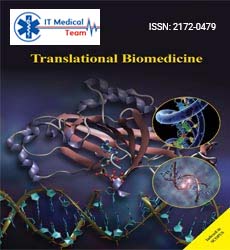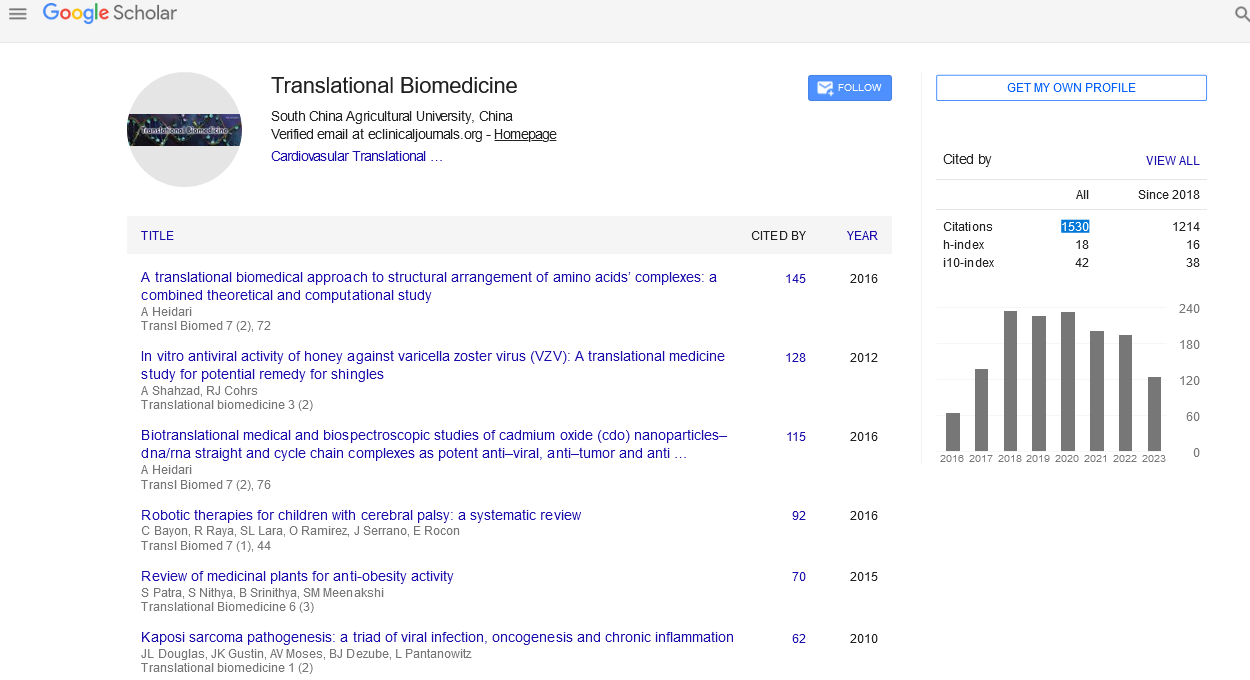Mini Review - (2022) Volume 13, Issue 6
Humans by Translation Process which Induced by Pluripotent Stem Cells.
Frank Jaenisch*
1Department of Biology, University of Glasgow, UK
*Correspondence:
Frank Jaenisch, Department of Biology, University of Glasgow,
UK,
Email:
Received: 02-Jun-2022, Manuscript No. Iptb-22- 12881;
Editor assigned: 08-Jun-2022, Pre QC No. PQ - 12881;
Reviewed: 22-Jun-2022, QC No. Q-22-12881;
Revised: 27-Jun-2022, Manuscript No. iptb-22-12881 (R);
Published:
01-Jul-2022, DOI: 10.21767/ 2172-0479.100237
Introduction
The future of biomedical research has undergone a significant change as a result of the possibility of altering the flexibility of terminally differentiated cells toward pluripotency. Humaninduced pluripotent stem cells offer a fresh source of therapeutic cells free of the moral quandaries or immunological restrictions associated with human embryonic stem cells. IPSCs also provide significant benefits over traditional approaches of studying human diseases. Three key uses of iPSC technology have emerged since its inception. Disease modelling, regenerative medicine and drug development. Here, we go over the most current developments in iPSC technology in connection to basic, clinical, and community health in great detail. Regenerative medicine has come a long way since the initial discovery that bone marrow cells have the ability to regenerate themselves through clonal proliferation, which established the field. These bone marrow cells have the ability to self-renew and differentiate into many cell types, making them a form of stem cell. The ability of nuclei to develop was the focus of earlier endeavours to study the pluripotency of the inner cell mass. These efforts included cloning in frogs, cloning in adult mammalian cells, deriving mouse and human embryonic stem cells, and producing ESCs and somatic cell fusion [1]. Similarly, the discovery that the mammalian transcription factor MyoD could transform fibroblasts into myocytes gave rise to the idea of master regulators, transcription factors that these paradigms were used to categorise newly identified stem cells as either adult stem cells or ESCs based on their origins and capacity for differentiation [2]. The extraordinary abilities of ESCs to self-renew without senescence and to generate all of the embryo's cell types made them exceptional and useful tools for researching cell destiny and tissue development [3]. Human ESCs were initially used in research on pluripotent stem cells; however, their usage was ethically debatable due to the necessity of destroying early-stage embryos during the ESC derivation process [4]. Additionally, practical considerations limited the use of these tissues for medicinal purposes because, by definition, any cells or tissues produced from human ESCs would be allotransplanted into the recipient patient, potentially necessitating lifelong immunosuppression and adult human cells to nuclear reprogramming to pluripotency constituted a landmark development in regenerative medicine [5].
These cells, known as induced pluripotent stem cells, promised to be a source of therapeutic cells devoid of the moral dilemmas or immunological restrictions associated with human ESCs while still preserving features like self-renewal and pluripotency [7]. Since that first finding, several developments have been made to improve the effectiveness of iPSC production and the security of the offspring lines. These advancements include the use of chemical agents to increase efficiency BIX-01294, valproic acid, -deoxycytidine], dexamethasone, TSA and, the use of alternative cell sources for reprogramming embryonic, foetal, and adult fibroblasts; neural stem cells; adipose stem cells; karat [8]. With the aim that one day iPSCs could be employed for regenerative medicine in the clinic, the academic community has made a significant push over the past ten years toward the efficient creation of safer PSCs. The clinical trial using iPSC-derived retinal pigment epithelial cells for the treatment of macular degeneration, albeit being temporarily stopped, demonstrates how far we have come in the development of clinical-grade stem cells. In the near future, iPSC technology will probably present more opportunities to learn about the pathophysiology of illnesses and find novel therapeutic compounds. Particularly, iPSCs can be produced from patients who have specific genetic abnormalities and differentiated into disease-relevant cell types, such as cardiomyocytes, for use in disease modelling.
Discussion
Similarly, with the aim of curing each patient by taking into account
his or her specific genetic makeup, this is precision medicine. The
objective is to comprehend the intricate mechanisms behind
diseases so that customised treatment regimens can be created
for each patient in accordance with their specific circumstance.
In this review article, we want to emphasise how iPSCs have the
potential to advance fundamental scientific research and provide
innovative therapeutics for use in clinical and public health applications. The simplicity and reproducibility of iPSC technology
are its major strengths. Although the safety and efficacy of iPSCs
have greatly improved over the past ten years, which is essential
for moving the technology toward clinical use, the mechanisms
involved in the efficient creation of iPSCs are still in the early
stages of development. These developing ideas bring up crucial,
fundamental issues that will be covered in the section below.
Many studies have tried to address this question, but the general
consensus is that the initial activity of the core plus-impotency
genes has a snowball effect that results in simultaneous activation
of the entire endogenous network of pluripotency genes and
inhibition of lineage-specific genes within the reprogrammed
somatic cells. The initial phase of reprogramming is associated
with cells undergoing metabolic changes and genome-wide
alterations in histone marks and methylation, followed by a
late maturation phase that causes defined changes in nuclear
structure, the cytoskeleton, and signalling pathways. Indeed,
by looking closely at these Mechanisms, researchers can now
obtain nearly perfect iPSCs by clearing previous roadblocks to
reprogramming. With the addition of just four transcription
factors, namely, Takahashi and Yamanaka made important
discoveries in mouse and human induced pluripotent stem
cells, respectively, in and. This strategy increased the likelihood
of autologous transplantation while avoiding the typical ethical
issues with ESCs. Numerous additional studies in the field of
pluripotent stem cells have been made possible by the discovery
of iPSCs, including the creation of "disease-in-a-dish" models
for drug-screening platforms, the generation of disease-specific
iPSCs lines to investigate the pathophysiology of diseases, and
the development of personalized treatments for autologous stem
cell transplantation. A year after starting a stem cell clinical trial in
patients with spinal cord injury, Geron Corporation discontinued
it due to changes in the company's commercial strategy. A fresh
round of first-in-human clinical investigations started in 2014. In
these trials, type 1 diabetes, age-related macular degeneration,
and spinal cord injuries are all treated using pluripotent stem
cell sources. Products based on PSC are now being developed for
the treatment of Parkinson's disease, heart failure, and various
other conditions. Despite the enormous promise of these PSC
sources, the risks vs benefits analysis for such cell therapies is not
simple because there are still significant obstacles that must be
overcome before they can be used in clinical settings. The clinical
translation of such experimental medicines may be proportionally
more difficult and time-consuming given that stem cell product
derivatives constitute a totally different therapy method. In
this Review article, we assess the technological and practical
challenges that these PSC derivatives have in being translated
into clinical practice and discuss potential solutions that could
help bring personalized or precision medicine closer to reality.
We also go through preclinical obstacles that must be overcome,
such as PSCs' inherent tumorigenic potential as a result of their
self-renewal and pluripotency, concerns brought on by their diverse differentiation into mature adult types, and problems
with immunogenicity, engraftment, and survival. In the article's
final section, The identification of the most effective techniques
for developing tissues for clinical use is one of the main objectives
as stem cell technology becomes a reality. Predicting clinical
needs, production requirements, and associated costs is essential
to effective commercialization planning. Stem cell technologies
require extensive planning because of their time-consuming
nature and expensive development expenses. PSCs, like ESCs or
iPSCs, are exceedingly adaptable and easily manufactured in huge
quantities. They are the perfect beginning materials for creating
scalable commercial cell products because of these advantageous
characteristics. However, there are a number of challenging
issues that arise when producing clinical-grade stem cell products
for a clinical trial that do not exist in a research setting. For
instance, reproducible manual handling in clean room facilities is
required to be created throughout the life cycle of the product.
GMPs should be used as early as possible in the process for the
optimum results. This can prevent further issues and guarantee
that the manufacturing process complies with quality control
standards set by regulatory agencies, resulting in the production
of a product that is affordable, reliable, scalable, secure, and
reproducible and has the best possible chance of being successful
on the market. The application of defined cultural systems should
be made with PSCs. Fatal bovine serum and mouse embryonic
fibroblasts are examples of materials of animal origin that should
not be used as support systems since they have the potential
to transmit xenopathogens to the recipient. For each batch of
manufactured cells, strict quality checks, documentation, and
adherence to current GMP are necessary.
Conclusion
Additionally, it is essential to make sure that products are
consistently produced and meet all requirements for viability,
function, purity, and sterility during the differentiation process.
Finally, certificates of analysis should be produced for all
product lots to certify them for clinical usage once the necessary
specifications are established. It is essential that the PSC products
used in the research are produced using procedures similar to
those intended for the final GMP product for preclinical animal
investigations. This is a crucial stage since the research might be
incorporated into later FDA-filed investigational new medication
applications. Despite the fact that efficient differentiation can be
achieved.
Acknowledgement
None
Conflict of Interest
None
References
- Kogler F, Sensken S, Airey JA (2004) A new human somatic stem cell from placental cord blood with intrinsic pluripotent differentiation potential. J Exp Med 200: 123-135.
Indexed at, Crossref, Google Scholar
- Marion RM, Strati K, Li H, Murga M, Blanco R et al. (2009) Â A p53-mediated DNA damage response limits reprogramming to ensure iPS cell genomic integrity. Nature 460: 1149-1153.
Indexed at, Crossref, Google Scholar
- Sadri Ardekani H, Atala A (2014) Testicular tissue cryopreservation and spermatogonial stem cell transplantation to restore fertility: from bench to bedside. Stem Cell Res Ther 5: 68.
Indexed at, Crossref, Google Scholar
- Woodsong C, Karim QA (2005) A model designed to enhance informed consent: experiences from the HIV prevention trials network. Am J Public Health 95: 412-419.
Indexed at, Crossref, Google Scholar
- Elsalanty ME, Genecov DG (2009) Bone grafts in craniofacial surgery. Craniomaxillofac Trauma Reconstr 2: 125-134
Indexed at, Crossref, Google Scholar
- Staerk, Staerk J, Dawlaty MM, Gao Q, Maetzel D et al. (2010) Reprogramming of peripheral blood cells into induced pluripotent stem cells. Cell Stem Cell 7: 20-24.
Indexed at, Crossref, Google Scholar
- Keung W, Boheler KR, Li RA (2014) Developmental cues for the maturation of metabolic, electrophysiological and calcium handling properties of human pluripotent stem cell-derived cardiomyocytes. Stem Cell Res Ther 5: 17.
Indexed at, Crossref, Google Scholar
- Chen JX, Krane M, Deutsch MA (2012) Inefficient reprogramming of fibroblasts into cardiomyocytes using Gata4, Mef2c, and Tbx5. Circ Res 111: 50-55.
Indexed at, Crossref, Google Scholar
Citation: Jaenisch F (2022) Humans by
Translation Process which Induced by
Pluripotent Stem Cells . Transl Biomed, Vol.
13 No. 6: 237.





